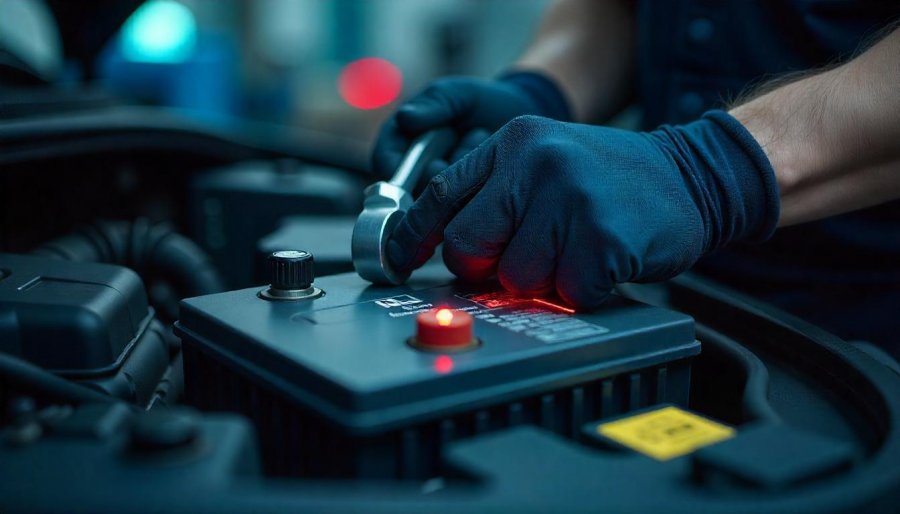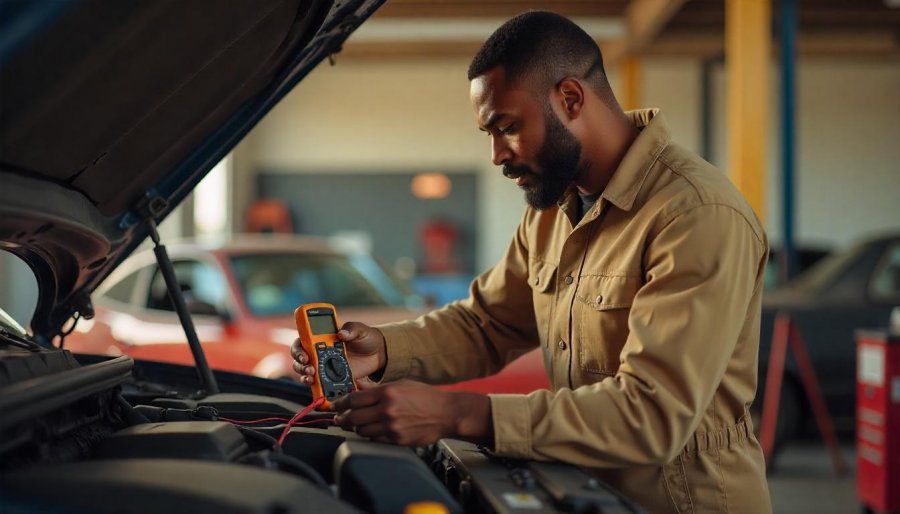
Imagine relying on your vehicle’s dependable start every time—no surprises, no roadside breakdowns. The secret? Routine battery maintenance. This small but vital component often gets overlooked until it fails at the worst moment. Regular checks for corrosion, loose connections, and voltage levels can dramatically extend your battery’s lifespan and ensure peace of mind. Extreme temperatures—hot summers and cold winters—accelerate wear, making proactive care even more critical. Are you ready to prevent those unexpected stalls and costly repairs? By adopting simple practices like cleaning terminals, tightening clamps, and monitoring physical signs of damage, you can stay ahead of potential failures. External factors like parking in shaded areas or insulating the battery add crucial protection. These small habits empower you to avoid roadside emergencies, transforming routine care into a shield against inconvenience. Isn’t it time you learned how a few minutes of maintenance can keep your car—and your confidence—running smoothly?

Start with a Healthy Battery for Worry-Free Driving
A reliable car depends on more than just regular oil changes or tire rotations; it starts with a healthy battery. This small but essential component supplies the power needed to start your engine and run your vehicle’s electronic systems. Yet, many drivers tend to overlook it until a problem arises—often at the worst possible moment. Regularly checking your battery’s condition is one of the simplest ways to keep your car dependable and prevent inconvenient breakdowns. Taking a few minutes every month to inspect and maintain your battery can make all the difference in ensuring your vehicle starts reliably, no matter the weather or situation.
Your car’s battery is the heart of its electrical system. It provides the initial spark needed to fire up the engine and keeps electronics like headlights, radios, and sensors functioning smoothly. When the battery isn’t in good shape, your car might refuse to start or stall unexpectedly, leaving you stranded. Especially during extreme temperatures—hot summers or freezing winters—a weak or compromised battery is more likely to fail. That’s why making battery maintenance a routine part of your vehicle care isn’t just smart; it’s essential for worry-free driving.
Many drivers only think about their battery when warning lights flash or the engine struggles to turn over. By then, small issues such as corrosion or a slightly weakened charge have already taken hold. These problems are often easily preventable with simple, consistent checks. Corrosion, which appears as white or bluish deposits on the terminals, can hinder electrical flow and reduce your battery’s effectiveness. Regular cleaning with a baking soda solution and a brush, along with ensuring tight connections, can keep your battery running at peak performance. These small steps help avoid surprises and extend the lifespan of your battery.
Extreme weather conditions accelerate battery wear. Hot summers cause internal components to break down faster, while cold winters make starting more difficult. Keeping an eye on your battery’s physical condition—looking for swelling, cracks, or leaks—is equally important. Damaged batteries can fail suddenly and pose safety risks. If you notice any physical signs of deterioration, replacing the battery promptly is the safest move. Incorporating these quick visual inspections into your routine ensures your vehicle remains reliable and ready to go wherever your day takes you.
In essence, maintaining your car battery isn’t complicated or time-consuming, but it’s incredibly effective. A few simple checks—like inspecting terminals, cleaning corrosion, tightening connections, and testing voltage—can prevent roadside emergencies and save you money on repairs. It’s about staying proactive rather than reactive, catching potential issues early before they turn into major problems. When your battery is in good shape, you gain peace of mind, knowing your car will start when you need it most. That’s the foundation of worry-free driving, built on a few minutes of routine care.

Master Key Practices to Maintain a Reliable Car Battery
Maintaining a healthy car battery is straightforward and surprisingly effective when done regularly. Start with simple visual inspections—once a month is ideal—to catch small issues before they become major problems. Look closely at the battery terminals for any signs of corrosion, which appears as a white, bluish, or greenish buildup. Corrosion can obstruct electrical flow, making it harder for your vehicle to start. A quick clean using a mixture of baking soda and water, applied with a brush or cloth, can clear away deposits and restore proper contact. Keeping the terminals clean is a simple step that pays off by ensuring reliable starts and smoother operation.
Equally important is checking that the clamps and connections are secure. Over time, vibrations from driving can loosen these connections, leading to intermittent starts or even unexpected stalling. After cleaning, tighten the clamps firmly, using a wrench if necessary, to make sure the battery is firmly attached. This small effort helps maintain steady electrical contact, which is critical for reliable engine starts. Regularly confirming tight connections prevents frustrating breakdowns, especially during colder months when batteries tend to struggle more.
Testing your battery’s voltage with a multimeter offers quick insight into its health. When the engine is off, a healthy battery should read around 12.6 volts. If the reading dips below 12.4 volts, it indicates the battery may be weakening or nearing the end of its lifespan. Performing this check once a month or before long trips helps identify early signs of trouble. Recognizing a declining voltage early gives you the chance to replace the battery before it leaves you stranded, particularly during winter cold snaps or extended drives.
Physical signs also serve as clear indicators for battery health. Swollen, cracked, or leaking batteries are unsafe and should be replaced immediately. Damage often results from exposure to extreme temperatures or aging, and ignoring these signs can lead to sudden, unpredictable failures. Handling damaged batteries with care and disposing of them responsibly is essential for safety and environmental reasons. Prompt replacement prevents unexpected breakdowns and keeps your vehicle dependable on the road.
External factors influence how long your battery will last. Parking in shaded or sheltered areas during hot weather reduces internal heat buildup, which accelerates internal wear. Conversely, in winter, insulating the battery with a blanket or using a battery warmer can help it withstand cold temperatures that hinder starting. These small precautions are simple but effective ways to extend your battery’s lifespan and avoid failure when you need your vehicle most. Incorporating climate-aware habits into your routine keeps your battery healthier over time.
Turning off electrical accessories when the engine isn’t running is a quick habit that can significantly extend your battery’s life. Lights, radios, and air conditioning draw power, and leaving them on drains the battery faster—especially if your car sits idle for a while. Developing the habit of shutting off these devices prevents unnecessary drain and reduces the strain on your battery. Over time, this simple practice preserves your battery’s charge, ensuring your vehicle starts reliably every time you turn the key.
Another effective tip is to avoid frequent short trips that don’t give your battery enough time to recharge. Short drives can drain the battery faster than it can recover, especially if electrical accessories are used during those trips. If you often make quick stops, consider taking longer drives periodically to allow the alternator to fully recharge the battery. This helps maintain optimal voltage levels and prevents premature wear, prolonging the life of your battery and ensuring dependable starts.
Finally, adopting these maintenance practices as part of your routine transforms how you care for your vehicle. Regularly inspecting terminals, cleaning corrosion, tightening connections, testing voltage, and observing physical signs become second nature. This proactive approach helps catch issues early, saving money and avoiding roadside emergencies. When your battery stays in top shape, your vehicle is more reliable, and you can enjoy worry-free driving with confidence that your car will start when you need it most. Simple, consistent care makes all the difference in keeping your vehicle running smoothly.

Avoid Roadside Breakdowns with Routine Battery Checks
Routine battery checks are one of the simplest yet most effective ways to prevent roadside breakdowns and keep your driving experience worry-free. Regularly inspecting your battery for signs of corrosion, loose connections, or low voltage helps you catch potential issues before they escalate into major failures. A quick visual scan for white, bluish, or greenish deposits on the terminals, combined with a simple cleaning if needed, can make a significant difference. Staying ahead of problems means your vehicle remains dependable, especially during cold mornings or busy days when a breakdown would cause real inconvenience.
Keeping your battery in top shape involves ensuring all connections are tight and secure. Over time, vibrations from driving can loosen clamps and bolts, leading to poor electrical flow. If your connections aren’t firm, your car might start intermittently or even refuse to start at all when you turn the key. Checking and tightening these connections regularly is a quick step that can save you from being stranded unexpectedly. A little effort here prevents frustrating breakdowns and provides peace of mind, knowing your vehicle is ready to go when you need it most.
Testing your battery’s voltage with a multimeter is a straightforward way to gauge its health. When the engine is off, a healthy battery should read around 12.6 volts. If the reading drops significantly below this, it’s a sign that the battery is weakening or nearing the end of its lifespan. Performing this simple check once a month or before long trips helps you spot early signs of trouble. Recognizing a declining voltage early gives you the chance to replace the battery before it leaves you stranded, especially during winter cold snaps or extended drives.
Physical signs of deterioration, like swollen or cracked casings or leaks, also signal that it’s time for a new battery. These issues often result from exposure to extreme temperatures or aging, and ignoring them can lead to sudden, unpredictable failures. Replacing a damaged or leaking battery promptly is the safest move. Handling it carefully and disposing of it responsibly not only keeps you safe but also prevents environmental harm. Addressing physical damage early helps avoid unexpected breakdowns and keeps your vehicle reliable on the road.
External factors play a crucial role in your battery’s longevity. Parking in shaded or sheltered areas during hot weather can significantly slow internal heat buildup, which accelerates internal wear. Conversely, in winter, insulating your battery with a blanket or using a battery warmer helps it withstand cold temperatures that make starting more difficult. These simple precautions are effective ways to extend your battery’s lifespan, ensuring it remains reliable when you need it most. Small climate-aware steps can make a big difference in preventing failure at inconvenient times.
Another quick but impactful habit is turning off electrical accessories when the engine isn’t running. Lights, radios, and air conditioning draw power, and leaving them on drains the battery faster—especially if your vehicle sits idle for a while. Developing the habit of shutting off these devices helps conserve the charge and reduces unnecessary strain. Over time, this simple practice preserves your battery’s health, ensuring your vehicle starts reliably every time. It’s a small change that pays off in fewer surprises and greater confidence behind the wheel.
Finally, avoiding frequent short trips that don’t give your battery enough time to recharge can help prevent unexpected failures. Short drives can drain the battery faster than the alternator can restore its energy, especially if electrical accessories are used during those trips. If you often make quick stops, consider taking longer drives periodically to let the battery fully recharge. This helps maintain optimal voltage levels and prolongs your battery’s life, keeping your vehicle dependable. Making these small adjustments in your driving habits can significantly reduce the risk of roadside emergencies, giving you peace of mind wherever your journey takes you.
Regular maintenance and proactive checks are essential for avoiding unexpected breakdowns. If you’re interested in learning more about how to keep your vehicle running smoothly, check out this helpful guide on vehicle maintenance tips. Staying informed about best practices ensures your car remains reliable and ready for any journey.


